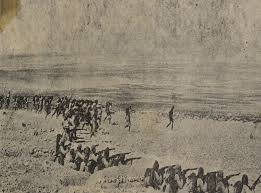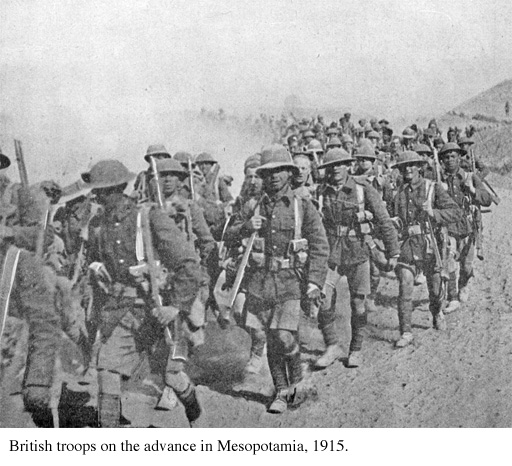Each Success Brings Greater Peril
Turks Withdraw, Then Toughen Stand
Special to The Great War Project
(29 September-1 October) In Mesopotamia — today’s Iraq — the British are about to seize the town of Kut, on the Tigris River a century ago.
It is not an easy task, and the British and their allied Indian forces suffer significant losses.
Earlier, the landing of the British and their Indian Allies at the head of the Persian Gulf encounters little resistance as they press north toward Baghdad. With ease they take Basra, then Qurna, and Nasiriya.
But the heat is terrible, and the soldiers experience debilitating thirst. “Thirst so intense,” writes historian Martin Gilbert, “that men were incapacitated.”
Consequently the Indian troops “seemed reluctant to storm the Turkish trench lines,” reports Gilbert.
“There was an additional cause for fear,” he writes. “On the first night of the battle, wounded men who could not be found in the intense blackness of the night were robbed by marauding Arabs, mutilated and murdered.”
Still it takes but a few days for the British to consolidate their hold on the territory south of Kut.
Initially the Turkish defenses are too weak and in disarray. The British do not view the Turks as formidable enemies. “Among the captured Turkish weapons was a Persian canon from the time of Napoleon; it was dated 1802.”
“The Anglo-Indian troops,” writes historian Eugene Rogan, “had gained in experience and won the self-confidence that came with repeated victories.”
Initially they seem unstoppable. “The British had come 380 miles from the sea,” reports Gilbert. “The way seemed clear” for further advances. Baghdad is only 22 miles away.
Still, marching on to Baghdad cannot take place without British reinforcements. British supply lines are stretched thinner and thinner as the British press northward.
As for the Ottoman forces, they are working tirelessly to bolster their defenses. “A dangerous new dynamic was transforming the Mesopotamian front to Britain’s disadvantage,” reports Rogan. “Ottoman numbers were expanding while British forces were being progressively depleted.”
The British plan a multi-front assault on the Turkish forces for September 28th, exactly one hundred years ago. But right away some British units get lost in the early morning attack. Contrary to plans, the British are forced to attack in broad daylight.
“The British not only lost the crucial element of surprise,” writes Rogan, “but also found themselves exposed to heavy artillery and machine-gun fire.”
“Ottoman forces put up a determined defense of their lines and inflicted heavy casualties on the exposed British attackers.”
“The two armies battered each other from dawn to sundown.”
That night the Ottoman forces silently withdraw. The way is open for the British to seize Kut. They do exactly that on September 28th.
“In the end,” observes Rogan, “the Turks did not force the British to fight further for Kut. British aerial reconnaissance reported on 29 September that the Ottomans had abandoned the town and completed an orderly retreat upriver towards Baghdad.”
But, writes Rogan, the British lose the opportunity to surround and destroy the Ottoman army. The ironic lesson: the British-Indian force “grew more vulnerable with every battle it won in Iraq.”


